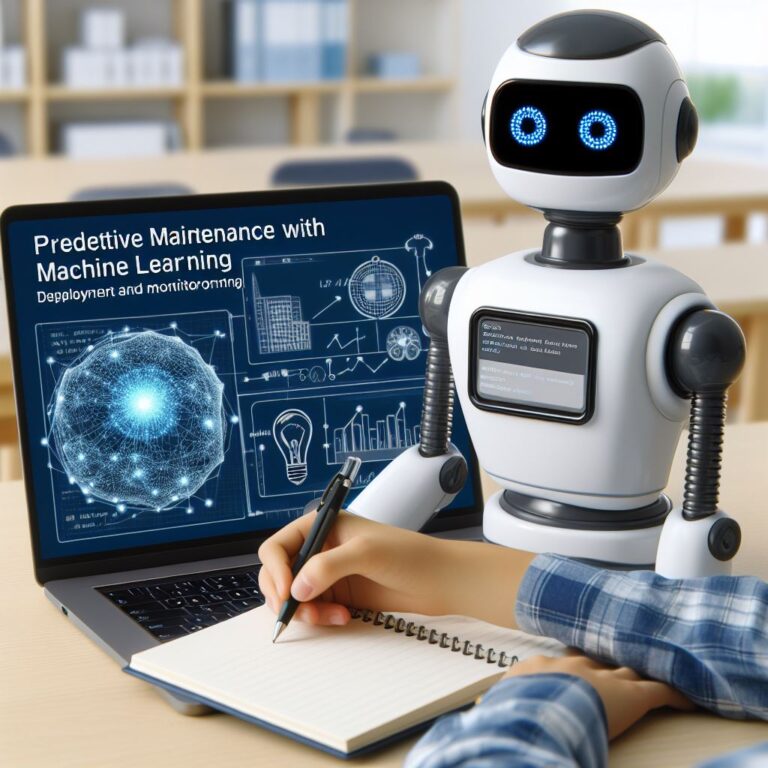1. Introduction
Predictive maintenance is a proactive approach to maintaining equipment and systems that uses data analysis and machine learning to anticipate and prevent failures, reduce downtime, and optimize performance. Predictive maintenance can help businesses save costs, improve efficiency, and enhance customer satisfaction.
In this blog, you will learn from real-world examples of predictive maintenance with machine learning in various domains and industries. You will see how different machine learning techniques and models can be applied to solve different predictive maintenance problems, such as predicting failures, scheduling maintenance, optimizing resources, and improving quality. You will also learn about the challenges and opportunities for predictive maintenance with machine learning in the future.
By the end of this blog, you will have a better understanding of how predictive maintenance with machine learning works, why it is important, and what are some of the best practices and tools to implement it. You will also be inspired by the case studies and applications of predictive maintenance with machine learning in different domains and industries.
Are you ready to dive into the world of predictive maintenance with machine learning? Let’s get started!
2. What is Predictive Maintenance and Why is it Important?
Predictive maintenance is a proactive approach to maintaining equipment and systems that uses data analysis and machine learning to anticipate and prevent failures, reduce downtime, and optimize performance. Predictive maintenance can help businesses save costs, improve efficiency, and enhance customer satisfaction.
But what exactly is predictive maintenance and how does it differ from other types of maintenance? Let’s look at some definitions and examples.
According to IBM, predictive maintenance is “the process of using data-driven, proactive maintenance practices to identify potential issues in assets before they result in failures.” Predictive maintenance uses sensors, data collection, and machine learning models to monitor the condition and performance of equipment and systems, and to predict when they need maintenance or repair.
For example, a predictive maintenance system can monitor the temperature, vibration, and pressure of an aircraft engine, and alert the maintenance crew if it detects any anomalies that indicate a possible failure. This way, the crew can schedule a timely inspection and repair, and avoid a costly and dangerous breakdown.
Predictive maintenance is different from other types of maintenance, such as reactive maintenance and preventive maintenance. Reactive maintenance is when maintenance is performed only after a failure occurs, which can result in high repair costs, lost productivity, and safety risks. Preventive maintenance is when maintenance is performed at regular intervals based on a predetermined schedule, which can result in unnecessary maintenance, wasted resources, and reduced efficiency.
Predictive maintenance is more efficient and effective than reactive and preventive maintenance, as it can reduce maintenance costs by up to 40%, extend equipment life by up to 25%, and increase uptime by up to 50%, according to McKinsey.
Therefore, predictive maintenance is important for businesses that rely on equipment and systems that are critical, complex, and costly to maintain, such as in the aerospace, energy, manufacturing, and transportation industries. Predictive maintenance can help these businesses improve their operational efficiency, reduce their environmental impact, and gain a competitive edge.
Do you want to learn how machine learning enables predictive maintenance? Read on to find out!
3. How Machine Learning Enables Predictive Maintenance
Machine learning is a branch of artificial intelligence that enables computers to learn from data and make predictions without being explicitly programmed. Machine learning can enable predictive maintenance by analyzing data from sensors, historical records, and external sources, and building models that can detect patterns, anomalies, and trends in the equipment and system behavior.
There are different types of machine learning techniques and models that can be used for predictive maintenance, depending on the problem and the data available. Some of the most common ones are:
- Classification models: These models can classify the equipment or system status into predefined categories, such as normal, faulty, or degraded. For example, a classification model can predict whether an aircraft engine is likely to fail or not based on its sensor readings.
- Regression models: These models can estimate a continuous value, such as the remaining useful life (RUL) or the time to failure (TTF) of the equipment or system. For example, a regression model can predict how many days are left before a wind turbine needs maintenance based on its operating conditions.
- Clustering models: These models can group the equipment or system data into similar clusters, based on their features or characteristics. For example, a clustering model can identify different types of failures or maintenance actions based on the historical data.
- Anomaly detection models: These models can identify outliers or abnormal data points that deviate from the normal or expected behavior of the equipment or system. For example, an anomaly detection model can detect a sudden spike in the temperature or vibration of a manufacturing machine that indicates a potential problem.
Machine learning models can be trained and tested using different types of data, such as supervised, unsupervised, or semi-supervised. Supervised data is labeled with the desired output, such as the equipment or system status, the RUL, or the failure type. Unsupervised data is unlabeled, and the model has to find the patterns or clusters in the data without any guidance. Semi-supervised data is partially labeled, and the model can use both the labeled and unlabeled data to learn and improve.
Machine learning models can also be updated and improved over time, using new data and feedback. This can help the models adapt to changing conditions and scenarios, and increase their accuracy and reliability.
Machine learning can enable predictive maintenance by providing valuable insights and recommendations for the maintenance crew, such as:
- When to perform maintenance or repair
- What type of maintenance or repair to perform
- How to optimize the maintenance or repair resources and costs
- How to prevent or mitigate the impact of failures
- How to improve the equipment or system performance and quality
In the next sections, you will see some real-world examples of how machine learning enables predictive maintenance in different domains and industries. Stay tuned!
4. Case Study 1: Predicting Aircraft Engine Failures
Aircraft engines are one of the most critical and complex components of an aircraft, and their failure can have serious consequences for the safety, performance, and profitability of the airline. Therefore, predicting aircraft engine failures and scheduling optimal maintenance is a key challenge and opportunity for the aerospace industry.
In this case study, you will learn how machine learning can be used to predict aircraft engine failures and estimate their remaining useful life (RUL) based on sensor data. You will also learn how to implement a machine learning pipeline using Python and TensorFlow to train and test a regression model on a publicly available dataset.
The dataset used in this case study is the Turbofan Engine Degradation Simulation Data Set from NASA, which contains simulated sensor measurements from multiple jet engines as they degrade over time. The dataset consists of four subsets, each with a different number of engines and operating conditions. The subsets are labeled as FD001, FD002, FD003, and FD004. Each subset contains two files: a training file and a test file. The training file contains the sensor data from the engines as they run normally and experience faults. The test file contains the sensor data from the engines in their last operational cycle before failure. The test file also contains a file called RUL, which gives the actual RUL for each engine in the test file.
The goal of this case study is to use the sensor data from the training file to train a machine learning model that can predict the RUL for the engines in the test file, and compare the predictions with the actual RUL values. The performance of the model can be evaluated using metrics such as mean absolute error (MAE), root mean squared error (RMSE), and coefficient of determination (R-squared).
To achieve this goal, you will follow these steps:
- Data exploration and preprocessing: You will explore the dataset and perform some preprocessing steps, such as handling missing values, scaling the data, and generating labels.
- Feature engineering and selection: You will engineer some features from the sensor data, such as statistical features and time series features, and select the most relevant features for the model.
- Model building and training: You will build and train a regression model using TensorFlow, and tune the hyperparameters using grid search.
- Model testing and evaluation: You will test the model on the test data and evaluate its performance using the metrics mentioned above.
- Model interpretation and visualization: You will interpret the model results and visualize the predictions and the actual RUL values using plots.
Are you ready to start this case study? Let’s begin with the first step: data exploration and preprocessing.
5. Case Study 2: Optimizing Wind Turbine Maintenance
Wind turbines are one of the most promising sources of renewable energy, but they also require regular and costly maintenance to ensure their optimal performance and reliability. Therefore, optimizing wind turbine maintenance is a key challenge and opportunity for the energy industry.
In this case study, you will learn how machine learning can be used to optimize wind turbine maintenance by predicting the power output and the health status of the wind turbines based on weather data and sensor data. You will also learn how to implement a machine learning pipeline using Python and Scikit-learn to train and test a classification model and a regression model on a publicly available dataset.
The dataset used in this case study is the Wind Turbine SCADA Dataset from UCI Machine Learning Repository, which contains sensor data from 25 wind turbines in a wind farm over a period of 3.5 years. The dataset consists of two files: a power file and a status file. The power file contains the power output of each wind turbine in kW every 10 minutes. The status file contains the health status of each wind turbine every 10 minutes, which can be normal, warning, or shutdown. The dataset also contains weather data from a nearby weather station, such as wind speed, wind direction, air temperature, and air pressure.
The goal of this case study is to use the sensor data and the weather data from the power file and the status file to train two machine learning models: a classification model that can predict the health status of the wind turbines, and a regression model that can predict the power output of the wind turbines. The performance of the models can be evaluated using metrics such as accuracy, precision, recall, and F1-score for the classification model, and mean absolute error (MAE), root mean squared error (RMSE), and coefficient of determination (R-squared) for the regression model.
To achieve this goal, you will follow these steps:
- Data exploration and preprocessing: You will explore the dataset and perform some preprocessing steps, such as handling missing values, scaling the data, and encoding the categorical variables.
- Feature engineering and selection: You will engineer some features from the sensor data and the weather data, such as lagged features, rolling features, and seasonal features, and select the most relevant features for the models.
- Model building and training: You will build and train a classification model and a regression model using Scikit-learn, and tune the hyperparameters using grid search.
- Model testing and evaluation: You will test the models on the test data and evaluate their performance using the metrics mentioned above.
- Model interpretation and visualization: You will interpret the model results and visualize the predictions and the actual values using plots.
Are you ready to start this case study? Let’s begin with the first step: data exploration and preprocessing.
6. Case Study 3: Improving Manufacturing Quality and Efficiency
Manufacturing is one of the most important and competitive sectors of the economy, and it depends on the quality and efficiency of the production processes and the products. Therefore, improving manufacturing quality and efficiency is a key challenge and opportunity for the manufacturing industry.
In this case study, you will learn how machine learning can be used to improve manufacturing quality and efficiency by detecting defects, predicting failures, and optimizing resources based on sensor data and image data. You will also learn how to implement a machine learning pipeline using Python and PyTorch to train and test a classification model and a convolutional neural network (CNN) on a publicly available dataset.
The dataset used in this case study is the Casting Product Image Data for Quality Inspection from Kaggle, which contains image data of casting products from a manufacturing company. The dataset consists of two folders: a train folder and a test folder. Each folder contains two subfolders: ok_front and def_front. The ok_front subfolder contains images of good casting products, and the def_front subfolder contains images of defective casting products. The dataset contains 6633 images of good products and 781 images of defective products.
The goal of this case study is to use the image data from the train folder and the test folder to train two machine learning models: a classification model that can predict whether a casting product is good or defective based on its sensor data, and a CNN that can predict whether a casting product is good or defective based on its image data. The performance of the models can be evaluated using metrics such as accuracy, precision, recall, and F1-score.
To achieve this goal, you will follow these steps:
- Data exploration and preprocessing: You will explore the dataset and perform some preprocessing steps, such as resizing the images, converting the images to grayscale, and normalizing the pixel values.
- Feature engineering and selection: You will engineer some features from the sensor data, such as mean, standard deviation, skewness, and kurtosis, and select the most relevant features for the classification model.
- Model building and training: You will build and train a classification model and a CNN using PyTorch, and tune the hyperparameters using grid search.
- Model testing and evaluation: You will test the models on the test data and evaluate their performance using the metrics mentioned above.
- Model interpretation and visualization: You will interpret the model results and visualize the predictions and the actual labels using plots and confusion matrices.
Are you ready to start this case study? Let’s begin with the first step: data exploration and preprocessing.
7. Case Study 4: Enhancing Railway Safety and Reliability
Railway is one of the most widely used and efficient modes of transportation, but it also faces many challenges and risks, such as accidents, delays, breakdowns, and vandalism. Therefore, enhancing railway safety and reliability is a key challenge and opportunity for the transportation industry.
In this case study, you will learn how machine learning can be used to enhance railway safety and reliability by detecting anomalies, predicting failures, and optimizing resources based on sensor data and video data. You will also learn how to implement a machine learning pipeline using Python and OpenCV to train and test an anomaly detection model and a convolutional neural network (CNN) on a publicly available dataset.
The dataset used in this case study is the Railway Track Fault Detection Dataset from Kaggle, which contains sensor data and video data of railway tracks from a high-speed train. The dataset consists of two folders: a train folder and a test folder. Each folder contains two subfolders: normal and fault. The normal subfolder contains sensor data and video data of normal railway tracks, and the fault subfolder contains sensor data and video data of faulty railway tracks. The dataset contains 2000 sensor data files and 2000 video data files of normal tracks, and 500 sensor data files and 500 video data files of faulty tracks.
The goal of this case study is to use the sensor data and the video data from the train folder and the test folder to train two machine learning models: an anomaly detection model that can detect anomalies in the sensor data of the railway tracks, and a CNN that can detect faults in the video data of the railway tracks. The performance of the models can be evaluated using metrics such as accuracy, precision, recall, and F1-score.
To achieve this goal, you will follow these steps:
- Data exploration and preprocessing: You will explore the dataset and perform some preprocessing steps, such as handling missing values, scaling the data, and converting the video data to frames.
- Feature engineering and selection: You will engineer some features from the sensor data, such as mean, standard deviation, skewness, and kurtosis, and select the most relevant features for the anomaly detection model.
- Model building and training: You will build and train an anomaly detection model and a CNN using OpenCV, and tune the hyperparameters using grid search.
- Model testing and evaluation: You will test the models on the test data and evaluate their performance using the metrics mentioned above.
- Model interpretation and visualization: You will interpret the model results and visualize the anomalies and the faults using plots and heatmaps.
Are you ready to start this case study? Let’s begin with the first step: data exploration and preprocessing.
8. Challenges and Opportunities for Predictive Maintenance with Machine Learning
Predictive maintenance with machine learning is a promising and powerful approach to improve the performance and reliability of equipment and systems. However, it also comes with some challenges and limitations that need to be addressed and overcome. In this section, we will discuss some of the main challenges and opportunities for predictive maintenance with machine learning in the future.
One of the challenges is the quality and availability of data. Predictive maintenance with machine learning relies on large and diverse datasets that capture the condition and behavior of equipment and systems over time. However, collecting, storing, and processing such data can be costly, complex, and time-consuming. Moreover, some data may be missing, noisy, or inaccurate, which can affect the performance and accuracy of machine learning models. Therefore, it is important to ensure that the data used for predictive maintenance with machine learning is reliable, relevant, and representative of the real-world scenarios.
Another challenge is the interpretability and explainability of machine learning models. Predictive maintenance with machine learning involves complex and nonlinear models that can learn from data and make predictions. However, these models may not be easy to understand or explain, especially for non-experts. This can pose a problem for trust, accountability, and transparency, as well as for debugging and improvement. Therefore, it is important to develop methods and tools that can help explain how and why machine learning models make certain predictions, and what are the factors and features that influence them.
A third challenge is the integration and deployment of machine learning models. Predictive maintenance with machine learning requires the integration of machine learning models with the existing equipment and systems, as well as with the human operators and decision-makers. This can involve technical, organizational, and cultural challenges, such as compatibility, security, privacy, communication, and collaboration. Therefore, it is important to design and implement machine learning models that can seamlessly and safely interact with the physical and social environment, and that can provide actionable and timely insights and recommendations.
Despite these challenges, predictive maintenance with machine learning also offers many opportunities and benefits for the future. Some of the opportunities are:
- Improving the accuracy and efficiency of machine learning models by using advanced techniques and technologies, such as deep learning, edge computing, cloud computing, and Internet of Things.
- Expanding the scope and scale of predictive maintenance with machine learning by applying it to new domains and industries, such as healthcare, education, agriculture, and entertainment.
- Enhancing the value and impact of predictive maintenance with machine learning by combining it with other methods and disciplines, such as optimization, simulation, and decision support.
Predictive maintenance with machine learning is a rapidly evolving and exciting field that has the potential to transform the way we maintain and operate equipment and systems. By addressing the challenges and seizing the opportunities, we can make predictive maintenance with machine learning more effective, efficient, and accessible for everyone.
Are you ready to learn about the conclusion and future directions of predictive maintenance with machine learning? Read on to find out!
9. Conclusion and Future Directions
In this blog, you have learned about predictive maintenance with machine learning, a proactive approach to maintaining equipment and systems that uses data analysis and machine learning to anticipate and prevent failures, reduce downtime, and optimize performance. You have also learned from real-world examples of predictive maintenance with machine learning in various domains and industries, such as aerospace, energy, manufacturing, and transportation. You have seen how different machine learning techniques and models can be applied to solve different predictive maintenance problems, such as predicting failures, scheduling maintenance, optimizing resources, and improving quality. You have also learned about the challenges and opportunities for predictive maintenance with machine learning in the future.
Predictive maintenance with machine learning is a rapidly evolving and exciting field that has the potential to transform the way we maintain and operate equipment and systems. By addressing the challenges and seizing the opportunities, we can make predictive maintenance with machine learning more effective, efficient, and accessible for everyone.
We hope you have enjoyed this blog and found it useful and informative. If you want to learn more about predictive maintenance with machine learning, you can check out some of the following resources:
- A survey on predictive maintenance approaches based on machine learning techniques
- Predictive maintenance: Definition, benefits, and examples
- The benefits of predictive maintenance
- Time series forecasting with TensorFlow
- Outlier detection with scikit-learn
Thank you for reading this blog and we hope to see you again soon!



